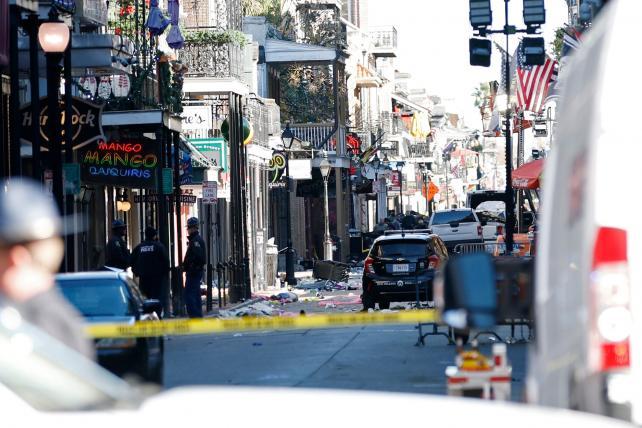
Why does Islamic State still have global reach?
It was a chilling sight as the fireman tentatively poked with a stick at the bones, hair and decomposed heap on the floor of the room before he and his colleague suddenly stepped back. “Daesh,” he said, the tone of his one-word warning suggesting that he had encountered something dangerous.
Moving tentatively, he stepped forward to tie some rope to what he warned was the remains of a suicide bomb belt before retiring behind a nearby wall for cover and slowly pulling on the line to remove the belt which on this occasion proved immobilised.
On the apartment block’s balcony outside meanwhile, the remains of another Islamic State (IS) group – Daesh – fighter was also discovered.
“This one used his belt, killed himself,” another fireman told me in broken English, as the remains of both jihadists were scooped into a heavy-duty zippered body bag by the crew.
The year was 2018 and the northern Syrian city of Raqqa which had served as IS’s seat of power and de-facto capital of its self-proclaimed caliphate for four years, had finally been liberated by the mainly Kurdish Syrian Democratic Forces (SDF).
For many, those days marked what was believed to be the beginning of the end of IS, the terrorist group that at its height controlled a swathe of territory the size of Britain across Iraq and Syria.
Today, there’s little doubt that IS is a shadow of the organisation that it once was, no longer possessing the base or manpower that enabled it to impose its brutal rule and carry out a wave of attacks in Europe and elsewhere almost a decade ago.
But IS has never really gone away and as the deadly New Year’s Day attack in the US city of New Orleans served to show, it remains a persistent threat to many countries from individuals inspired by extremist Islamist groups.
US president-elect Donald Trump’s instinctive reaction to the attack was to claim it had been carried out by an illegal immigrant.
“This is what happens when you have OPEN BORDERS, with weak, ineffective, and virtually non-existent leadership,” Trump wrote on social media. But nothing could be further from the truth.
Texas born and bred, what fully motivated Shamsud-Din Jabbar, a 42-year-old American citizen and military veteran to ram a rented Ford pickup truck into a crowd of revellers on Bourbon Street in New Orleans in the early hours of January 1, killing at least 14 and injuring 39, remains to be explained.
But what is indisputable, according to the FBI, is that the attacker had previously posted videos on social media indicating that IS had inspired him to kill and that a black IS flag flew from the bumper of the truck driven by Jabbar.
IS has long used vehicle attacks, having inspired extremists to conduct similar atrocities in Nice, Berlin, Stockholm, and New York City over the years.
“By carrying an IS flag with him during the attack, the suspect wanted to show that he was a true believer, aligned with the IS cause, and perhaps hoping to trigger others into following suit,” Colin P Clarke, a counterterrorism analyst at The Soufan Center, a security consulting firm based in New York told The New York Times (NYT).
Equally notabe too, is that Jabbar’s attack represents the first major assault on an American city by an individual purportedly influenced by IS, or one of its affiliates, since a 2017 truck assault in New York City that killed eight.
According to data collected by Professor Charles Kurzman, a specialist in Middle East and Islamic studies at the University of North Carolina at Chapel Hill, since IS’s peak nearly a decade ago, the number of violent plots that Muslim Americans planned or carried out for extremist groups has plummeted, from 94 in 2015 to just three in 2023.
But if the New Orleans attack was indeed inspired by IS, it will have been the latest in a string of recent strikes carried out across the world this past year under the IS banner.
In January 2024, the group’s Afghan affiliate, known as IS-Khorasan or IS-K, carried out twin bombings in Iran at a memorial procession for Qasem Soleimani a top Iranian general who was killed in a US drone strike four years earlier. More than 80 people were killed and scores were injured. IS counts both America and Iran’s Shia theocratic regime as mortal enemies.
The memorial bombing was followed by an attack on a Roman Catholic church in Istanbul later that month, and then came another particularly bloody one in March at a concert hall near Moscow that some analysts say was also carried out by IS-K.
In the US alone, according to The Soufan Center, a number of significant IS-inspired plots and attacks have been thwarted in recent months by US intelligence.
In September, a Pakistani citizen trying to enter the US from Canada was arrested for plotting an attack targeting a Jewish centre in Brooklyn in support of IS.
In October, an Afghan national, in coordination with IS-K recruiters, planned a mass attack to be executed on US Election Day.
In mid-October, police arrested a teenager in Arizona for plotting an IS-inspired attack on the Phoenix Pride parade through an improvised drone with explosives. Then, in November, a 28-year-old US citizen in Houston was arrested for plotting a terrorist attack on local military recruiting centres and providing material support to the IS, including offering his apartment as a safehouse for IS operatives.
Elsewhere, with its decentralised network of affiliates that have sprouted across parts of Asia and especially Africa, IS has had greater success.
This past weekm while not making the same headlines as the attacks in New Orleans, IS in Somalia said it conducted an attack with 12 militants and two booby-trapped vehicles that killed more than 20 military personnel. It was that IS offshoot’s largest attack to date, experts say. Earlier in March last year, an IS affiliate operating in the West African nation of Niger claimed responsibility for an assault it said killed 30 soldiers.
All these attacks underscore the important point that though IS’s territorial caliphate – the area in Syria and Iraq in which it assumed both political and religious authority – has now gone, the group’s ability to inspire acts of terror on foreign soil through online propaganda and ideological influence remains scarily formidable.
As Bruce Hoffman, a counterterrorism scholar at the Council on Foreign Relations, think tank summed it up to The Economist magazine recently, essentially “2024 was IS’s year of resurrection.”
But this then beggars the question, why now for such an uptick in activity?
In answering this question say security experts, the first thing is to recognise that IS has never really gone away. Yes, its capacity to strike has been diminished but it has never been eradicated.
The second factor as intelligence officials have been warning for many months now is that extremist groups thrive in volatile, chaotic places, and right now the world has no shortage of such environments.
The collapse of the regime of President Bashar al-Assad in Syria is a point in case, with the Biden administration last month stressing it was “clear-eyed about the fact that IS will try to take advantage of any vacuum to reestablish its capability”.
The demise of the Assad regime has also led to conflict between US-backed Kurdish forces and Turkish-backed rebels, prompting concerns that IS may exploit the instability.
According to a July report from a UN Security Council committee, there are now believed to be between 1500 and 3000 IS fighters across Syria and Iraq, as the group “continues to face battlefield losses, desertions, and recruitment challenges”.
But a US Central Command statement in September warned that a particular focus for the group was to free the roughly 9000 IS detainees held in more than 20 detention facilities across Syria, a mission that could be undertaken by the thousands of IS fighters who remain at large in the north of the country.
Then there is the “Gaza issue” where Israel’s war there has “reinforced the ideology that the West sees Muslim life as cheap and expendable”, said David Schanzer, a professor at Duke University speaking to The Economist. The carnage in Gaza has effectively radicalised many and this along with an uptick and improvement in propaganda has enabled IS and other extremist groups to fully mobilise its recruiting sergeants.
It’s estimated that some 60% of IS propaganda now comes from sub-Saharan Africa. This includes affiliate groups in Nigeria, the Democratic Republic of Congo and Mozambique, according to US security analysts who have been monitoring the group’s growth in the politically unstable African Sahel region, which is now an epicentre of IS activity.
Counterterrorism officials tasked with tracking such activity have divided IS attacks into three broad categories. The first is “Directed”. At least five successful attacks in the 2010s are known to have been directed outright by IS, carried out by operatives who trained with the group in Iraq and Syria. These are among the deadliest, including those in Paris in 2015 and the Brussels Airport and subway bombings in 2016.
The second category is “Enabled”, whereby violence is conceived and guided by IS operatives whose only connection to the attacker is through the internet. And finally the third category is “Inspired”, those so-called lone wolf attackers like Shamsud-Din Jabbar in New Orleans last week who are radicalised through online propaganda and carry out attacks on their own.
Analysts however also point to a wider factor that might have aided IS’s recent resurrection. Some for example believe that the US government’s focus on counterterrorism has been overshadowed by bigger conflicts and great power strategy like Russia’s war in Ukraine, and tensions with China or Iran. This they say has effectively deflected from the threats posed by Islamist-inspired terrorism.
According to Jason Blazakis, a professor at the Middlebury Institute of International Studies who was cited recently by The Economist, there are fears too that the incoming Trump administration’s promise to slash federal budgets could damage intelligence gathering and its lean towards isolationism could also give groups like IS and al-Qaeda space to grow overseas.
The case of the New Orleans attacker also raises another broader question about domestic radicalisation within the US. As Edward Luce, columnist and US national editor at the Financial Times observed, “the bigger picture is that political violence is on the rise in the US”.
“An online terrorist cult seems to have given purpose to Jabbar’s unhappiness and a target for his rage – hedonistic American revellers. Had he been white Christian rather than brown Muslim, he would probably have found his doomsday epiphany in some branch of QAnon or a white supremacist group,” noted Luce in a recent column.
As it is, Jabbar was celebrated last week among IS supporters online in various chatrooms including among English-speaking supporters. He was praised too for the various operational security measures he employed to execute his New Orleans plot successfully.
According to The Soufan Center, for weeks prior to Jabbar’s attack, there had been calls on various IS Telegram and Rocket.Chat accounts for terrorist attacks over Christmas and New Year as the group sought to seize momentum heading into 2025.
Jabbar’s lone wolf attack was just one response to such a call.
As such it had all the hallmarks of IS’s modus operandi that began after its ousting from Raqqa almost a decade ago. It’s a sobering reminder that Islamist-inspired terrorism still has the capacity to reach far beyond the Middle East and even more worryingly still, a new impetus to drive it.
Source » thenational.scot





